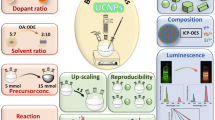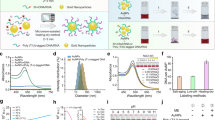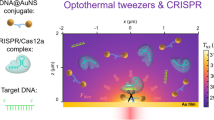Abstract
Fluorescence resonance energy transfer (FRET) reporters are commonly used in the final stages of nucleic acid amplification tests to indicate the presence of nucleic acid targets, where fluorescence is restored by nucleases that cleave the FRET reporters. However, the need for dual labelling and purification during manufacturing contributes to the high cost of FRET reporters. Here we demonstrate a low-cost silver nanocluster reporter that does not rely on FRET as the on/off switching mechanism, but rather on a cluster transformation process that leads to fluorescence color change upon nuclease digestion. Notably, a 90 nm red shift in emission is observed upon reporter cleavage, a result unattainable by a simple donor-quencher FRET reporter. Electrospray ionization–mass spectrometry results suggest that the stoichiometric change of the silver nanoclusters from Ag13 (in the intact DNA host) to Ag10 (in the fragments) is probably responsible for the emission colour change observed after reporter digestion. Our results demonstrate that DNA-templated silver nanocluster probes can be versatile reporters for detecting nuclease activities and provide insights into the interactions between nucleases and metallo-DNA nanomaterials.
This is a preview of subscription content, access via your institution
Access options
Access Nature and 54 other Nature Portfolio journals
Get Nature+, our best-value online-access subscription
$29.99 / 30 days
cancel any time
Subscribe to this journal
Receive 12 print issues and online access
$259.00 per year
only $21.58 per issue
Buy this article
- Purchase on Springer Link
- Instant access to full article PDF
Prices may be subject to local taxes which are calculated during checkout






Similar content being viewed by others
Data availability
Source data are provided with this paper and available online at https://doi.org/10.5281/zenodo.10394146.
Code availability
The code designed for data collection and analysis of this study is available online at https://doi.org/10.5281/zenodo.10394146.
References
Notomi, T. et al. Loop-mediated isothermal amplification of DNA. Nucleic Acids Res. 28, e63–e63 (2000).
Piepenburg, O., Williams, C. H., Stemple, D. L. & Armes, N. A. DNA detection using recombination proteins. PLoS Biol. 4, e204 (2006).
Fozouni, P. et al. Amplification-free detection of SARS-CoV-2 with CRISPR–Cas13a and mobile phone microscopy. Cell 184, 323–333 (2021).
Chen, J. S. et al. CRISPR–Cas12a target binding unleashes indiscriminate single-stranded DNase activity. Science 360, 436–439 (2018).
Gootenberg, J. S. et al. Nucleic acid detection with CRISPR–Cas13a/C2c2. Science 356, 438–442 (2017).
Holland, P. M., Abramson, R. D., Watson, R. & Gelfand, D. H. Detection of specific polymerase chain reaction product by utilizing the 5′–3′ exonuclease activity of Thermus aquaticus DNA polymerase. Proc. Natl Acad. Sci. USA 88, 7276–7280 (1991).
Broughton, J. P. et al. CRISPR–Cas12-based detection of SARS-CoV-2. Nat. Biotechnol. 38, 870–874 (2020).
Marras, S. A., Kramer, F. R. & Tyagi, S. Efficiencies of fluorescence resonance energy transfer and contact-mediated quenching in oligonucleotide probes. Nucleic Acids Res. 30, e122–e122 (2002).
Yeh, H.-C., Sharma, J., Han, J. J., Martinez, J. S. & Werner, J. H. A. DNA–silver nanocluster probe that fluoresces upon hybridization. Nano Lett. 10, 3106–3110 (2010).
O’Neill, P. R., Gwinn, E. G. & Fygenson, D. K. UV excitation of DNA stabilized Ag cluster fluorescence via the DNA bases. J. Phys. Chem. C 115, 24061–24066 (2011).
Petty, J. T., Zheng, J., Hud, N. V. & Dickson, R. M. DNA-templated Ag nanocluster formation. J. Am. Chem. Soc. 126, 5207–5212 (2004).
Yeh, H.-C. et al. A fluorescence light-up Ag nanocluster probe that discriminates single-nucleotide variants by emission color. J. Am. Chem. Soc. 134, 11550–11558 (2012).
Blevins, M. S. et al. Footprints of nanoscale DNA–silver cluster chromophores via activated-electron photodetachment mass spectrometry. ACS Nano 13, 14070–14079 (2019).
Copp, S. M. et al. Magic numbers in DNA-stabilized fluorescent silver clusters lead to magic colors. J. Phys. Chem. Lett. 5, 959–963 (2014).
He, C., Goodwin, P. M., Yunus, A. I., Dickson, R. M. & Petty, J. T. A split DNA scaffold for a green fluorescent silver cluster. J. Phys. Chem. C 123, 17588–17597 (2019).
Schultz, D. et al. Evidence for rod-shaped DNA-stabilized silver nanocluster emitters. Adv. Mater. 25, 2797–2803 (2013).
Petty, J. T. et al. Optical sensing by transforming chromophoric silver clusters in DNA nanoreactors. Anal. Chem. 84, 356–364 (2012).
Chen, J. et al. CRISPR/Cas precisely regulated DNA-templated silver nanocluster fluorescence sensor for meat adulteration detection. J. Agric. Food Chem. 70, 14296–14303 (2022).
Lee, C. Y., Park, K. S., Jung, Y. K. & Park, H. G. A label-free fluorescent assay for deoxyribonuclease I activity based on DNA-templated silver nanocluster/graphene oxide nanocomposite. Biosens. Bioelectron. 93, 293–297 (2017).
Kuo, Y. A. et al. Massively parallel selection of nanocluster beacons. Adv. Mater. 34, e2204957 (2022).
Chen, Y.-A. et al. Nanocluster beacons enable detection of a single N6-methyladenine. J. Am. Chem. Soc. 137, 10476–10479 (2015).
Obliosca, J. M. et al. A complementary palette of nanocluster beacons. ACS Nano 8, 10150–10160 (2014).
Cerretani, C., Kanazawa, H., Vosch, T. & Kondo, J. Crystal structure of a NIR-emitting DNA-stabilized Ag16 nanocluster. Angew. Chem. Int. Ed. 58, 17153–17157 (2019).
Petty, J. T. et al. A DNA-encapsulated silver cluster and the roles of its nucleobase ligands. J. Phys. Chem. C 122, 28382–28392 (2018).
Koszinowski, K. & Ballweg, K. A highly charged Ag64+ core in a DNA‐encapsulated silver nanocluster. Chem. Eur. J. 16, 3285–3290 (2010).
Gonzalez-Rosell, A. et al. Chloride ligands on DNA-stabilized silver nanoclusters. J. Am. Chem. Soc. 145, 10721–10729 (2023).
Huard, D. J. et al. Atomic structure of a fluorescent Ag8 cluster templated by a multistranded DNA scaffold. J. Am. Chem. Soc. 141, 11465–11470 (2018).
Markham, N. R. & Zuker, M. UNAFold: software for nucleic acid folding and hybridization. Methods Mol. Biol. 453, 3–31 (2008).
Cong, X. et al. Determining membrane protein–lipid binding thermodynamics using native mass spectrometry. J. Am. Chem. Soc. 138, 4346–4349 (2016).
McCabe, J. W. et al. Variable-temperature electrospray ionization for temperature-dependent folding/refolding reactions of proteins and ligand binding. Anal. Chem. 93, 6924–6931 (2021).
Ramachandran, A. & Santiago, J. G. CRISPR enzyme kinetics for molecular diagnostics. Anal. Chem. 93, 7456–7464 (2021).
Nguyen, L. T., Smith, B. M. & Jain, P. K. Enhancement of trans-cleavage activity of Cas12a with engineered crRNA enables amplified nucleic acid detection. Nat. Commun. 11, 4906 (2020).
Nalefski, E. A. et al. Kinetic analysis of Cas12a and Cas13a RNA-guided nucleases for development of improved CRISPR-based diagnostics. iScience 24, 102996 (2021).
Yeh, H.-C., Sharma, J., Han, J. J., Martinez, J. S. & Werner, J. H. A beacon of light. IEEE Nanotechnol. Mag. 5, 28–33 (2011).
Juul, S. et al. Nanocluster beacons as reporter probes in rolling circle enhanced enzyme activity detection. Nanoscale 7, 8332–8337 (2015).
Ge, L., Sun, X., Hong, Q. & Li, F. Ratiometric nanocluster beacon: a label-free and sensitive fluorescent DNA detection platform. ACS Appl. Mater. Interfaces 9, 13102–13110 (2017).
Suo, T. et al. A versatile turn-on fluorometric biosensing profile based on split aptamers-involved assembly of nanocluster beacon sandwich. Sens. Actuators B 324, 128586 (2020).
Gwinn, E., Schultz, D., Copp, S. M. & Swasey, S. DNA-protected silver clusters for nanophotonics. Nanomaterials 5, 180–207 (2015).
Zou, X., Kang, X. & Zhu, M. Recent developments in the investigation of driving forces for transforming coinage metal nanoclusters. Chem. Soc. Rev. 52, 5892–5967 (2023).
Leytus, S. P., Melhado, L. L. & Mangel, W. F. Rhodamine-based compounds as fluorogenic substrates for serine proteinases. Biochem. J. 209, 299–307 (1983).
Broto, M. et al. Nanozyme-catalysed CRISPR assay for preamplification-free detection of non-coding RNAs. Nat. Nanotechnol. 17, 1120–1126 (2022).
Hu, Q. et al. DNAzyme-based faithful probing and pulldown to identify candidate biomarkers of low abundance. Nat. Chem. 16, 122–131 (2023).
Fort, K. L. et al. Implementation of ultraviolet photodissociation on a benchtop Q exactive mass spectrometer and its application to phosphoproteomics. Anal. Chem. 88, 2303–2310 (2016).
Sanders, J. D. et al. Enhanced ion mobility separation and characterization of isomeric phosphatidylcholines using absorption mode Fourier transform multiplexing and ultraviolet photodissociation mass spectrometry. Anal. Chem. 94, 4252–4259 (2022).
Acknowledgements
This work was supported by the National Science Foundation grants (CBET2029266 to H.-C.Y. and J.S.B., and CBET2041340 to M.J.K.) and the National Institutes of Health grant (EY033106 to H.-C.Y.). The authors thank I. C. Santos for improving the ESI–MS analysis workflow on DNA/AgNCs, S. Kim for her assistance in the RNase A experiment and A. Yeh for his assistance in the revision.
Author information
Authors and Affiliations
Contributions
S.H. and H.-C.Y. conceived the project and designed the experiments. S.H. designed the DNA sequences for Subak reporters and mutation tests to optimize the reporters. S.H. developed a gel-purification method to purify DNA/AgNCs. S.H. performed DNase I, Cas12a and RNase A experiments. A.T.L. and J.M. performed fluorescence measurements and developed a Python code for excitation–emission matrices analysis. S.H. and J.N.W. prepared the samples for MS measurements. J.N.W. performed MS measurements and data analysis with assistance from S.W.J.S. and J.S.B. J.S.B. supervised all MS experiments and data analysis. T.D.N., Y.-A.K. and Y.-I.C. collected the absorption data. Y.H. and A.-T.N. checked the buffer compatibility for DNase I digestion and in vitro CRISPR–Cas reaction. M.L.G. and M.J.K. optimized the AgNC synthesis. S.H. and H.-C.Y. wrote the article with input from all authors. H.-C.Y. supervised the project.
Corresponding author
Ethics declarations
Competing interests
The authors declare no competing interests.
Peer review
Peer review information
Nature Nanotechnology thanks the anonymous reviewers for their contribution to the peer review of this work.
Additional information
Publisher’s note Springer Nature remains neutral with regard to jurisdictional claims in published maps and institutional affiliations.
Supplementary information
Supplementary Information
Supplementary Tables 1–4, Equations 1 and 2, Figs. 1–29, Videos 1–4 and Source Data 1–5.
Supplementary Video 1
Fluorescence changes of gel-purified Subak-1 under UV excitation during DNase I digestion.
Supplementary Video 2
Fluorescence changes of gel-purified Subak-2 (II in Fig. 5) under UV excitation during DNase I digestion.
Supplementary Video 3
Visible colour changes of gel-purified Subak-1 during DNase I digestion.
Supplementary Video 4
Visible colour changes of gel-purified Subak-2 (II in Fig. 5) during DNase I digestion.
Source data
Source Data Fig. 2
Unprocessed gel.
Source Data Fig. 3
Unprocessed gel.
Source Data Fig. 5
Unprocessed gel.
Source Data Fig. 2
Statistical source data.
Source Data Fig. 6
Statistical source data.
Rights and permissions
Springer Nature or its licensor (e.g. a society or other partner) holds exclusive rights to this article under a publishing agreement with the author(s) or other rightsholder(s); author self-archiving of the accepted manuscript version of this article is solely governed by the terms of such publishing agreement and applicable law.
About this article
Cite this article
Hong, S., Walker, J.N., Luong, A.T. et al. A non-FRET DNA reporter that changes fluorescence colour upon nuclease digestion. Nat. Nanotechnol. (2024). https://doi.org/10.1038/s41565-024-01612-6
Received:
Accepted:
Published:
DOI: https://doi.org/10.1038/s41565-024-01612-6



